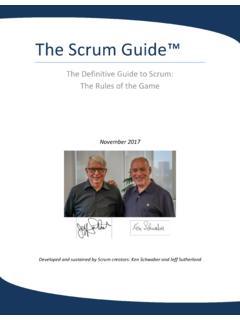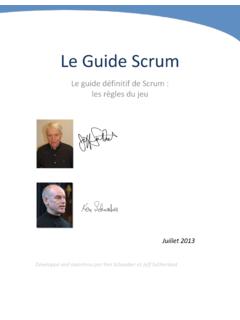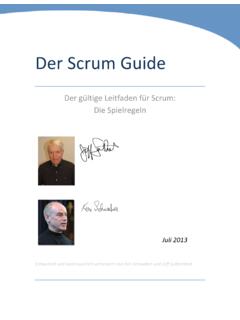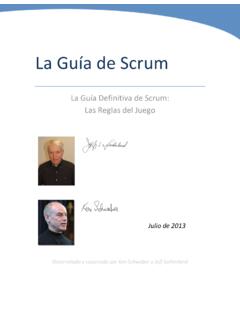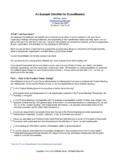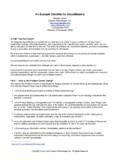Transcription of The Scrum Guide
1 The Scrum Guide The Definitive Guide to Scrum : The Rules of the Game July 2013 Developed and sustained by Ken Schwaber and Jeff Sutherland 2014 and ScrumInc. Offered for license under the Attribution Share-Alike license of Creative Commons, accessible at and also described in summary form at By utilizing this Scrum Guide you acknowledge and agree that you have read and agree to be bound by the terms of the Attribution Share-Alike license of Creative Commons. Page | 2 Table of Contents Purpose of the Scrum Guide .. 3 Definition of 3 Scrum Theory .. 3 The Scrum Team .. 4 The Product Owner .. 5 The Development Team.
2 5 The Scrum Master .. 6 Scrum Events .. 7 The Sprint .. 7 Sprint Planning .. 8 Daily Scrum .. 10 Sprint 11 Sprint Retrospective .. 12 Scrum Artifacts .. 12 Product Backlog .. 12 Sprint Backlog .. 14 Increment .. 15 Artifact Transparency .. 15 Definition of Done .. 15 End Note .. 16 Acknowledgements .. 16 People .. 16 History .. 16 2014 and ScrumInc. Offered for license under the Attribution Share-Alike license of Creative Commons, accessible at and also described in summary form at By utilizing this Scrum Guide you acknowledge and agree that you have read and agree to be bound by the terms of the Attribution Share-Alike license of Creative Commons.
3 Page | 3 Purpose of the Scrum Guide Scrum is a framework for developing and sustaining complex products. This Guide contains the definition of Scrum . This definition consists of Scrum s roles, events, artifacts, and the rules that bind them together. Ken Schwaber and Jeff Sutherland developed Scrum ; the Scrum Guide is written and provided by them. Together, they stand behind the Scrum Guide . Definition of Scrum Scrum (n): A framework within which people can address complex adaptive problems, while productively and creatively delivering products of the highest possible value. Scrum is: Lightweight Simple to understand Difficult to master Scrum is a process framework that has been used to manage complex product development since the early 1990s.
4 Scrum is not a process or a technique for building products; rather, it is a framework within which you can employ various processes and techniques. Scrum makes clear the relative efficacy of your product management and development practices so that you can improve. The Scrum framework consists of Scrum Teams and their associated roles, events, artifacts, and rules. Each component within the framework serves a specific purpose and is essential to Scrum s success and usage. The rules of Scrum bind together the events, roles, and artifacts, governing the relationships and interaction between them. The rules of Scrum are described throughout the body of this document.
5 Specific tactics for using the Scrum framework vary and are described elsewhere. Scrum Theory Scrum is founded on empirical process control theory, or empiricism. Empiricism asserts that knowledge comes from experience and making decisions based on what is known. Scrum employs an iterative, incremental approach to optimize predictability and control risk. Three pillars uphold every implementation of empirical process control: transparency, inspection, and adaptation. 2014 and ScrumInc. Offered for license under the Attribution Share-Alike license of Creative Commons, accessible at and also described in summary form at By utilizing this Scrum Guide you acknowledge and agree that you have read and agree to be bound by the terms of the Attribution Share-Alike license of Creative Commons.
6 Page | 4 Transparency Significant aspects of the process must be visible to those responsible for the outcome. Transparency requires those aspects be defined by a common standard so observers share a common understanding of what is being seen. For example: A common language referring to the process must be shared by all participants; and, Those performing the work and those accepting the work product must share a common definition of Done . Inspection Scrum users must frequently inspect Scrum artifacts and progress toward a Sprint Goal to detect undesirable variances. Their inspection should not be so frequent that inspection gets in the way of the work.
7 Inspections are most beneficial when diligently performed by skilled inspectors at the point of work. Adaptation If an inspector determines that one or more aspects of a process deviate outside acceptable limits, and that the resulting product will be unacceptable, the process or the material being processed must be adjusted. An adjustment must be made as soon as possible to minimize further deviation. Scrum prescribes four formal events for inspection and adaptation, as described in the Scrum Events section of this document: Sprint Planning Daily Scrum Sprint Review Sprint Retrospective The Scrum Team The Scrum Team consists of a Product Owner, the Development Team, and a Scrum Master.
8 Scrum Teams are self-organizing and cross-functional. Self-organizing teams choose how best to accomplish their work, rather than being directed by others outside the team. Cross-functional teams have all competencies needed to accomplish the work without depending on others not part of the team. The team model in Scrum is designed to optimize flexibility, creativity, and productivity. Scrum Teams deliver products iteratively and incrementally, maximizing opportunities for feedback. Incremental deliveries of Done product ensure a potentially useful version of working product is always available. 2014 and ScrumInc.
9 Offered for license under the Attribution Share-Alike license of Creative Commons, accessible at and also described in summary form at By utilizing this Scrum Guide you acknowledge and agree that you have read and agree to be bound by the terms of the Attribution Share-Alike license of Creative Commons. Page | 5 The Product Owner The Product Owner is responsible for maximizing the value of the product and the work of the Development Team. How this is done may vary widely across organizations, Scrum Teams, and individuals. The Product Owner is the sole person responsible for managing the Product Backlog. Product Backlog management includes: Clearly expressing Product Backlog items; Ordering the items in the Product Backlog to best achieve goals and missions; Optimizing the value of the work the Development Team performs; Ensuring that the Product Backlog is visible, transparent, and clear to all, and shows what the Scrum Team will work on next; and, Ensuring the Development Team understands items in the Product Backlog to the level needed.
10 The Product Owner may do the above work, or have the Development Team do it. However, the Product Owner remains accountable. The Product Owner is one person, not a committee. The Product Owner may represent the desires of a committee in the Product Backlog, but those wanting to change a Product Backlog item s priority must address the Product Owner. For the Product Owner to succeed, the entire organization must respect his or her decisions. The Product Owner s decisions are visible in the content and ordering of the Product Backlog. No one is allowed to tell the Development Team to work from a different set of requirements, and the Development Team isn t allowed to act on what anyone else says.
